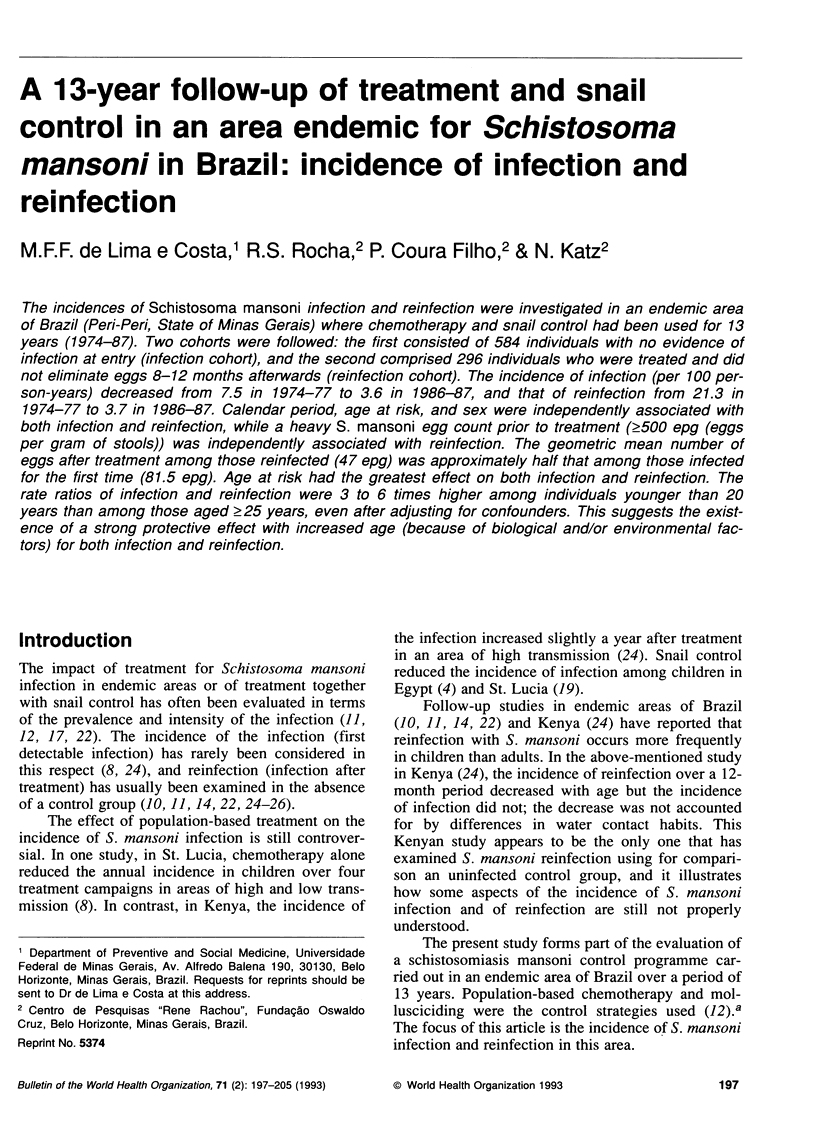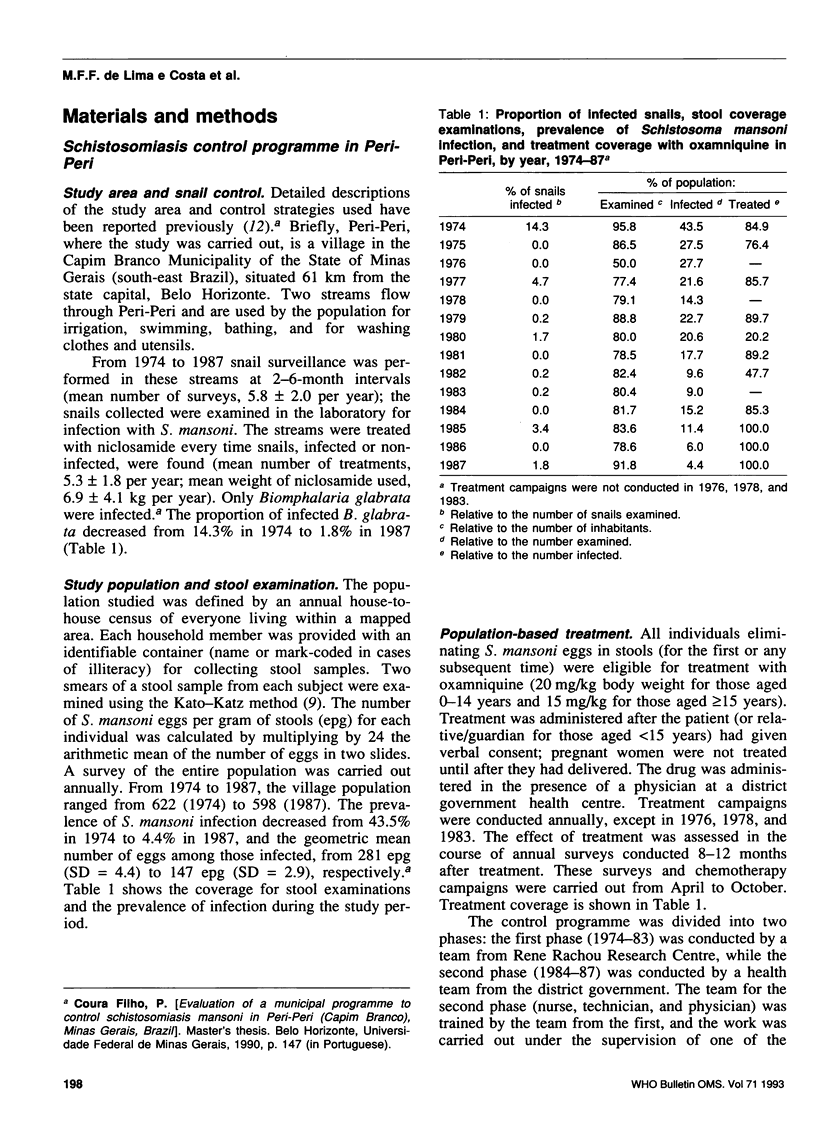Abstract
The incidences of Schistosoma mansoni infection and reinfection were investigated in an endemic area of Brazil (Peri-Peri, State of Minas Gerais) where chemotherapy and snail control had been used for 13 years (1974-87). Two cohorts were followed: the first consisted of 584 individuals with no evidence of infection at entry (infection cohort), and the second comprised 296 individuals who were treated and did not eliminate eggs 8-12 months afterwards (reinfection cohort). The incidence of infection (per 100 person-years) decreased from 7.5 in 1974-77 to 3.6 in 1986-87, and that of reinfection from 21.3 in 1974-77 to 3.7 in 1986-87. Calendar period, age at risk, and sex were independently associated with both infection and reinfection, while a heavy S. mansoni egg count prior to treatment (> or = 500 epg (eggs per gram of stools)) was independently associated with reinfection. The geometric mean number of eggs after treatment among those reinfected (47 epg) was approximately half that among those infected for the first time (81.5 epg). Age at risk had the greatest effect on both infection and reinfection. The rate ratios of infection and reinfection were 3 to 6 times higher among individuals younger than 20 years than among those aged > or = 25 years, even after adjusting for confounders. This suggests the existence of a strong protective effect with increased age (because of biological and/or environmental factors) for both infection and reinfection.
Full text
PDF








Selected References
These references are in PubMed. This may not be the complete list of references from this article.
- Bensted-Smith R., Anderson R. M., Butterworth A. E., Dalton P. R., Kariuki H. C., Koech D., Mugambi M., Ouma J. H., arap Siongok T. K., Sturrock R. F. Evidence for predisposition of individual patients to reinfection with Schistosoma mansoni after treatment. Trans R Soc Trop Med Hyg. 1987;81(4):651–654. doi: 10.1016/0035-9203(87)90442-1. [DOI] [PubMed] [Google Scholar]
- Farooq M., Hairston N. G., Samaan S. A. The effect of area-wide snail control on the endemicity of bilharziasis in Egypt. Bull World Health Organ. 1966;35(3):369–375. [PMC free article] [PubMed] [Google Scholar]
- Jordan P., Bartholomew R. K., Grist E., Auguste E. Evaluation of chemotherapy in the control of Schistosoma mansoni in Marquis Valley, Saint Lucia. I. Results in humans. Am J Trop Med Hyg. 1982 Jan;31(1):103–110. doi: 10.4269/ajtmh.1982.31.103. [DOI] [PubMed] [Google Scholar]
- Katz N., Chaves A., Pellegrino J. A simple device for quantitative stool thick-smear technique in Schistosomiasis mansoni. Rev Inst Med Trop Sao Paulo. 1972 Nov-Dec;14(6):397–400. [PubMed] [Google Scholar]
- Katz N., Rocha R. S. Double-blind clinical trial comparing praziquantel with oxamniquine in schistosomiasis mansoni. Rev Inst Med Trop Sao Paulo. 1982 Sep-Oct;24(5):310–314. [PubMed] [Google Scholar]
- Katz N., Rocha R. S., Pereira J. P. Schistosomiasis control in Peri-Peri (Minas Gerais, Brazil) by repeated clinical treatment and molluscicide application. Rev Inst Med Trop Sao Paulo. 1980 Jan-Feb;22(1 Suppl 4):85-93, 203-11. [PubMed] [Google Scholar]
- Katz N., Zicker F., Rocha R. S., Oliveira V. B. Re-infection of patients in schistosomiasis mansoni endemic areas after specific treatment. I--influence of age and worm burden. Rev Inst Med Trop Sao Paulo. 1978 Sep-Oct;20(5):273–278. [PubMed] [Google Scholar]
- Lima e Costa M. F., Magalhães M. H., Rocha R. S., Antunes C. M., Katz N. Water-contact patterns and socioeconomic variables in the epidemiology of schistosomiasis mansoni in an endemic area in Brazil. Bull World Health Organ. 1987;65(1):57–66. [PMC free article] [PubMed] [Google Scholar]
- Mahmoud A. A., Siongok T. A., Ouma J., Houser H. B., Warren K. S. Effect of targeted mass treatment on intensity of infection and morbidity in schistosomiasis mansoni. 3-year follow-up of a community in Machakos, Kenya. Lancet. 1983 Apr 16;1(8329):849–851. doi: 10.1016/s0140-6736(83)91388-0. [DOI] [PubMed] [Google Scholar]
- Prentice M. A., Jordan P., Bartholomew R. K., Grist E. Reduction in transmission of Schistosoma mansoni by a four-year focal mollusciciding programme against Biomphalaria glabrata in Saint Lucia. Trans R Soc Trop Med Hyg. 1981;75(6):789–798. doi: 10.1016/0035-9203(81)90415-6. [DOI] [PubMed] [Google Scholar]
- Sleigh A. C., Hoff R., Mott K. E., Maguire J. H., da França Silva J. T. Manson's schistosomiasis in Brazil: 11-year evaluation of successful disease control with oxamniquine. Lancet. 1986 Mar 22;1(8482):635–637. doi: 10.1016/s0140-6736(86)91721-6. [DOI] [PubMed] [Google Scholar]
- Tingley G. A., Butterworth A. E., Anderson R. M., Kariuki H. C., Koech D., Mugambi M., Ouma J. H., Arap Siongok T. K., Sturrock R. F. Predisposition of humans to infection with Schistosoma mansoni: evidence from the reinfection of individuals following chemotherapy. Trans R Soc Trop Med Hyg. 1988;82(3):448–452. doi: 10.1016/0035-9203(88)90159-9. [DOI] [PubMed] [Google Scholar]
- Wilkins H. A. Reinfection after treatment of schistosome infections. Parasitol Today. 1989 Mar;5(3):83–88. doi: 10.1016/0169-4758(89)90008-2. [DOI] [PubMed] [Google Scholar]


